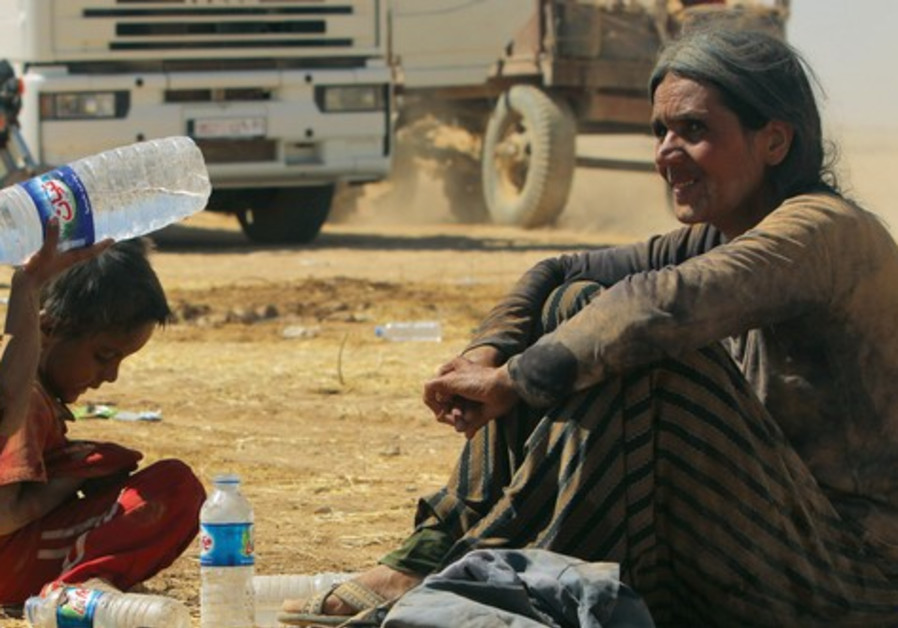Yazidis who saw genocide still insecure in Iraq’s Sinjar region

Displaced people from the minority Yazidis rest Monday near Iraq’s border with Syria while fleeing Sunni militants. . (photo credit: REUTERS)
On Friday, Yazidis in the Sinjar region of northern Iraq said they saw a US army column in their area. Photos of the Mine-Resistant Ambush Protected (MRAP)-style vehicles quickly spread on social media as locals and supporters suggested it was part of larger US move to counter Iranian-backed Shi’ite militias and establish influence over the nearby strategic border area with Syria.
In fact, it was a column of vehicles destined for anti-ISIS operations near the Syrian border.
The rumors and speculation come almost four years after Islamic State first invaded large swaths of northern Iraq and illustrate the feelings of insecurity among locals for whom ISIS crimes are still fresh.
Last month has been another difficult time in Sinjar and among the hundreds of thousands of Yazidis who are still displaced in Iraq and living in camps, mostly in the Kurdistan autonomous region. Accidental fires from cooking – in the tents that these people are still living in after almost four years – are a regular occurrence. On June 1 fires ravaged a camp near Zakho; a seventeen-year old teen was burned to death in another accidental fire at Khanke refugee camp in May.
Birgitta Schulke, a reporter for Germany’s public international broadcaster Deutsche Welle who visited Sinjar city, found that 85% of it was still destroyed, and posted photos of Yazidis living in tents on the mountain they fled to in August 2014 when ISIS attacked. Yet this area has been liberated from ISIS since 2015 – so why hasn’t it been rebuilt?
The answer lies partly in the changing political fortunes of the area and the fact that the central government and international community do not see its reconstruction as a priority. The US launched air strikes in August 2014 to stop ISIS attacks on Yazidis, but the anti-ISIS campaign has now moved beyond that original mission.
Initially, Kurdish People’s Protection Units (YPG) and Peshmerga helped liberate parts of Sinjar. In October, however, the Peshmerga left and the Iraqi security forces, including pro-Iranian Shi’ite militias, moved into Sinjar. After pressure from Turkey the YPG and other pro-Kurdistan Workers Party (PKK) groups also left Sinjar. With the area firmly in Iraqi central government control, locals wondered if aid would finally arrive – but instead they found dozens of checkpoints, many run by a plethora of militias set up around Sinjar.
During the May Iraqi elections only three Yazidis were elected to the parliament and many Yazidis in IDP (Internally Displaced Person) camps complained that their votes were not counted.
WHEN US vehicles drove through Sinjar on the way to the Syrian border, locals wondered if this would bring more security. A police commander in Nineveh claimed the US would build a base on Sinjar. A deputy-mayor of Sinjar also told Kurdistan 24 the same thing. Some recalled that the US had been active in Sinjar from 2003 to 2010 before the withdrawal from Iraq.
However, the Press Affairs office of the Coalition said that the forces, “in close coordination with our Iraqi partners, are repositioning assets to support phase two of Operation Roundup, which will continue operations to accelerate the defeat of Daesh remnants.” This included ISIS fighters near the Iraq-Syria border region.
The coalition also noted that “there is no such thing as a permanent US or coalition base in Iraq or Syria. All military bases in Iraq are under the Government of Iraq’s control,” and other positions are “temporary in nature” and function to “set conditions for follow up operations to increase regional stability.”
For Yazidis, stability in their region appears far off. Khalid Murad, brother of UN Goodwill Ambassador Nadia Murad and a survivor of the genocide, took a Rudaw reporter around his village of Kocho recently. He told how men from the village had been machine-gunned and dumped into mass graves, and women sold into slavery.
“I was hidden among the second group of killed Yazidis,” he said, describing scenes reminiscent of the Holocaust. Half of the 6,000 Yazidi women kidnapped by ISIS are still missing. Murad showed Rudaw a makeshift memorial in his village. “Still,” Khalid says, “no one has returned to Kocho.”





Comments are closed.